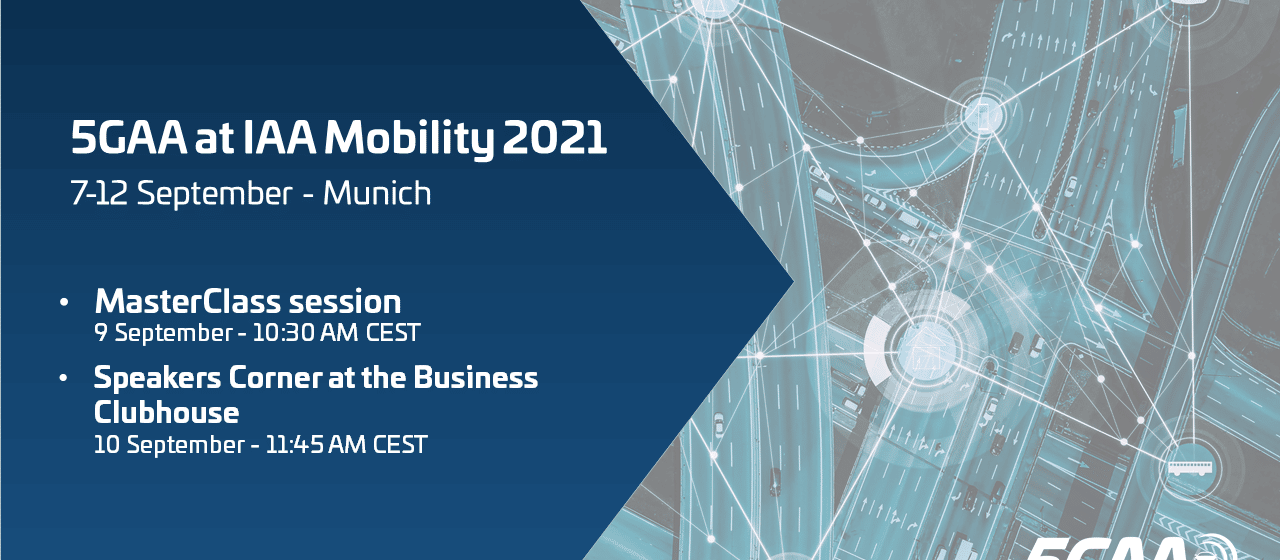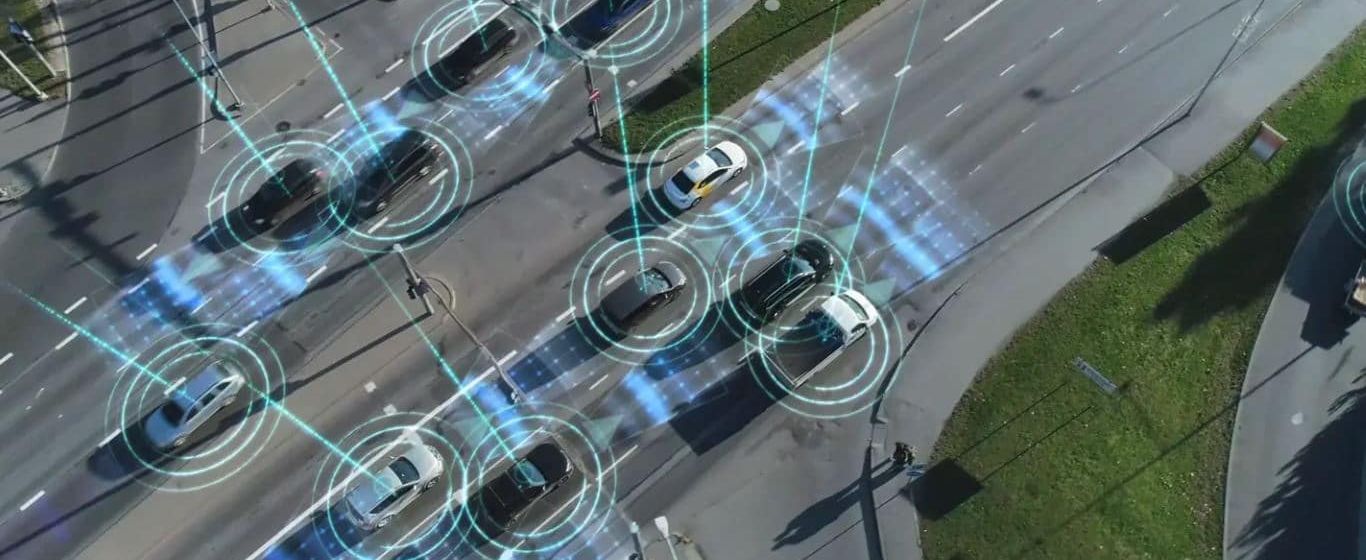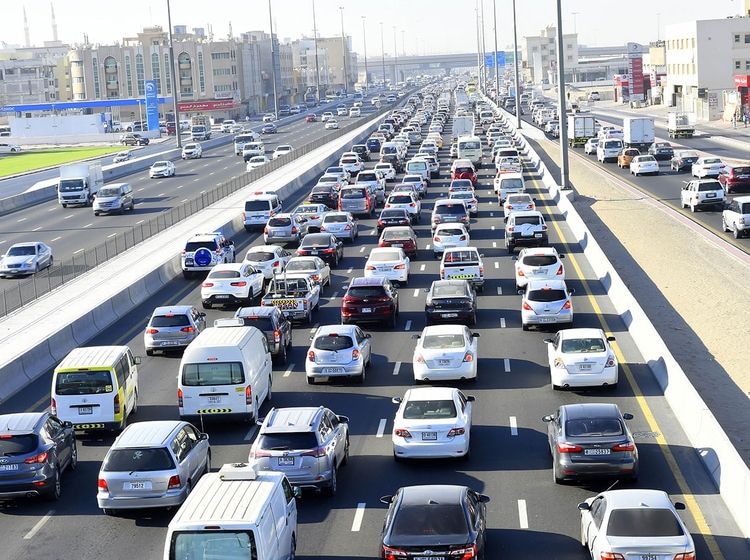
5GAA to participate in IAA Munich Mobility Conference 2021
The 5G Automotive Association (5GAA) is proud to announce its participation in the IAA Mobility Conference 2021 that will take place from 7 to 12 September in Munich. IAA Mobility is the leading global platform for the mobility industry and brings together actors from the entire mobility chain.
Following the guiding theme “What will move us next” the discussion will focus on how automation, connectivity, and smart city solutions will drive our progression to a more sustainable and effective mobility.
The event will provide an excellent platform to discuss the future of mobility with relevant stakeholders of the transport ecosystem.
5GAA will be active at two occasions:
- 9 September 2021 10.30 AM CEST
5GAA will hold a Master Class session. A great opportunity to engage in cross-industry exchange, present our expertise in an educational format, and discuss last updates and automated mobility by demonstrating the capabilities and deployment models of the Cellular Vehicle to Everything (“C-V2X”) technology.
- 10 September 2021, 11.45 AM CEST
5GAA will be present with its own Speaker Corner in the Business Club House, located in the central area of the exhibition. During 90 minutes our association and its members will have the opportunity to have speakers discuss the latest topics on connected mobility, as well as enjoy networking opportunities.
More details on the content of the sessions will come in the following weeks.

Tele-Operated Driving (ToD): Business Considerations
The 5GAA cross-working group work item Tele-operated Driving (ToD) aims to describe the requirements and framework needed for remote vehicle operation. The proposed results should reliably enable remote steering and manoeuvring including a human remote driver with both Direct and Indirect Control in an OEM-agnostic, inter-MNO and cross-authority operation. The intention of this work item is to study both use case and scenario definition, technical design, and business considerations. This document focuses on business considerations and aspires to identify the different elements that should be taken into account when considering the deployment of a ToD ecosystem from a business perspective.
Read the full technical report here.

Safety Treatment in V2X Applications
This White Paper describes the new challenges in the treatment of functional safety arising from the introduction of connected and distributed functions, which are typical for cellular vehicle-to-everything (C-V2X) applications. A dedicated 5GAA technical working group performed a detailed analysis to determine, propose, and evaluate possibilities for mobile network operators, vendors, and any further identified stakeholders to provide vehicle original equipment manufacturers (OEMs) what they need to treat safety in new use cases enabled by C-V2X technologies.
Read the full White Paper here.

5GAA and GCF Announce New Agreement on C-V2X Certification Programme
The newly announced programme will provide trusted foundation for C-V2X applications globally.
The 5G Automotive Association (5GAA) and the Global Certification Forum (GCF) have agreed on a new programme that will support the drive for interoperability, reliability, and safety of emerging cellular vehicle-to-everything (C-V2X) systems.
C-V2X – which allows direct wireless communication between vehicles, and between vehicles and the infrastructures on the roadways – is an essential enabler for a safer and more efficient intelligent transportation system. It therefore requires a certification process to ensure compliance with global standards and to provide reliability to manufacturers and users alike.
The newly established programme will enable manufacturers to certify their C-V2X capable products – including onboard units (OBU) and roadside units (RSU) – for C-V2X PC5 Mode 4 functionality.
Many actors of the C-V2X ecosystem will be able to benefit from the new programme. Tier 1 manufacturers of OBUs and RSUs can ensure their products are interoperable with each other in terms of V2V functionality; vehicle manufacturers can rely on intelligent connectivity within automobiles; and insurance companies will have the opportunity to monitor for safe driving practices. Municipal traffic authorities will also be able to trust in the potential of products to operate over their infrastructure, maintaining traffic flows, and all road users – including cyclists and pedestrians, as well as drivers – can look forward to the safer roads promised by intelligent mobility.
GCF’s certification scheme has been evolving since 1999 in alignment with developments in the wireless communication industry. This result stems from the collaboration 5GAA and GFC have reinforced since 2019, to investigate the principles and framework for a certification programme – designed specifically for C-V2X technologies.
This represents the first part of a multiphase certification programme that will evolve from radio layer certification of PC5 Mode 4 (V2V and V2I) to LTE and 5G-NR based V2X-Uu (V2N) using the 4G and 5G cellular network for communications, taking advantage of the increased functionality and performance that 5G brings.
For more information and to register your interest in the new GCF C-V2X certification programme, click here.
Read the press release here.

5G Automotive Association Discusses the Acceleration of 5G Deployment on European Roads at MCW Barcelona 2021
The 5G Automotive Association (5GAA) – with the engagement of EU representatives and stakeholders of the C-2VX ecosystem – has discussed the latest developments, opportunities, and challenges presented by connected mobility and 5G-V2X technology at the Mobile World Congress Barcelona 2021.
BARCELONA, 28 June 2021 – The 5G Automotive Association (5GAA) presented the latest global deployments of ‘Cellular Vehicle to everything’ (C-2VX) and 5G technologies at GSMA’s Mobile World Congress Barcelona 2021. The conference offered an overview on the broad-scale improvements that connected mobility can bring to the global automotive system, highlighting the benefits the technology brings in Europe and beyond.
The association disclosed the last global updates of 5G-V2X technology which will enable real-time connection between vehicles and their surroundings – starting today with LTE-V2X technology. 5G-powered vehicles are expected to hit the European market this year, as 5GAA members are leading C-V2X deployment through network based, direct communications on the continent. Technological progress supports more advanced use cases and the combination of long-range and short-range connectivity will grant the optimal setup for safety and efficiency of traffic.
“In the next two to three years, our association expects to see mass deployment of vehicle-to everything (V2X) use cases geared towards improving traffic efficiency and road safety around the world”, said 5GAA Director-General Johannes Springer. From 2024 onwards, 5GAA further anticipates the large-scale introduction of advanced safety and automated driving use cases supported by C-V2X. 5GAA supports the ecosystem by identifying these required use cases and services which are expected to be enabled by 5G-V2X in the coming decade. This enables European stakeholders to engage and collaborate in order to scale up V2X services and deliver societal benefits.
5GAA also underlined the strong need for a harmonised regulatory approach that will stimulate innovative business models and grant European competitiveness. The association favours a technology-neutral regulatory framework that will be focused on service delivery and will foster market-led innovation. Only an enabling and future-proof regulatory environment, conducive to C-V2X rapid deployment by OEMs and road authorities, will improve road safety and reach climate-neutrality.
The association highlighted 5G-powered vehicles are already commercialized in China. However, there are some relevant improvements in C-V2X implementation and 5G accessibility on roads in Europe. Many cities and road operators are starting to offer internet interfaces with real-time traffic information such as red light space, slippery roads and even wrong-way-drivers warning.
For one, Dieter Hötzer – Vice President Automated Driving Systems at Bosch – illustrated the Wrong Way Driver Solution developed by the 5GAA member company, as a clear example of technology that greatly impacts road safety. The software needs a GPS signal transferred to a cloud system that alerts drivers going the wrong way and warns other vehicles in the danger zone, sending out almost instant push notifications.
5G provides a revolutionary impact on the automotive system bringing several benefits and it is the result of a steady technology evolution. While it improves traffic efficiency minimising travel times and traffic jams, it also increases road safety by reducing road fatalities.
“Ensuring rapid and efficient deployment of 5G along broad networks is critically important to the future of mobility and will result in numerous safety benefits” concluded Springer.

Deployment band configuration for C-V2X at 5.9 GHz in Europe
This position paper describes 5GAA’s view on deployment band configuration for C-V2X in the 5.9 GHz band. It is our view that the C-V2X industry needs to agree on a commonly applied and unique deployment band configuration for C-V2X direct communications in the 5.9 GHz band. With such an agreement, C-V2X equipment can be configured identically in all vehicles for operation in the 5.9 GHz band, thereby paving the way to interference-free operation of ITS services across Europe.
The deployment band configuration outlined in this paper addresses the initial deployment of C-V2X technologies.

Cross-Working Group Work Item Network Reselection Improvements (NRI)
When user equipment (UE) changes its serving mobile network (e.g. when crossing country borders), an interruption in connectivity can occur as the UE needs to connect to a new network which takes some time, i.e. scanning for a public land mobile network that it can attempt to use or ‘visit’ (hence VPLMN).
These interruptions can often result in disconnected phone calls and/or blackout periods for connected vehicle services lasting up to several minutes. This report seeks to look at this problem and examine the potential solutions available.

C-V2X – Future proof and compatibility
Cellular vehicle-to-everything, or C-V2X, allows vehicles to communicate with each other and everything around them.
The technology is based on the same radio technologies used for mobile networks around the world and standardised by 3GPP, the global standardisation organisation for all mobile networks.
Millions of vehicles are already connected today.
Discover more about C-V2X on the video below.

Use Case Implementation Description Report
This report presents the results of the 5GAA work item Use Case Implementation Description.
Use cases examined include Cross-Traffic Left-Turn Assist (LTA), Emergency Brake Warning and Traffic Jam Warning and Route Information. The UCIDs in this Report provide a first step to achieving greater information-sharing between actors by bringing together existing pieces (specifications, profiles, interface descriptions, etc.). Likewise, the descriptions provide guidance on how to leverage the benefits of combining C-V2X’s multiple communication paths in order to realise the use cases.

STiCAD Safety Treatment in Connected and Automated Driving Functions
This STiCAD work item seeks to determine, propose and evaluate possibilities for telecommunication operators, vendors, and any further identified stakeholders to provide what is necessary in order to enable the car OEM to better treat safety for systems that exist beyond a single-vehicle. To achieve this, it was decided to find representative safety requirements for two selected use cases that cover the V2X scenarios of direct communication and network-based information delivery.


